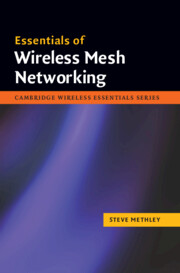Book contents
- Frontmatter
- Contents
- Preface
- Acknowledgements
- 1 Mesh overview and terminology
- 2 Attractive mesh attributes and applications
- 3 Fundamentals of mesh technology
- 4 Mesh capacity, scalability and efficiency – hypothesis testing
- 5 Mesh susceptibility
- 6 Mesh services and quality of service
- 7 Summary of potential mesh pitfalls to avoid
- 8 Appropriate telecommunications applications for mesh
- 9 Successful mesh implementations
- 10 Wireless sensor networks (WSNs) as mesh networks
- Abbreviations
- Selected definitions
- Appendix: Mobility models
- About the author
- Index
- Mesh hints and tips
3 - Fundamentals of mesh technology
Published online by Cambridge University Press: 01 March 2010
- Frontmatter
- Contents
- Preface
- Acknowledgements
- 1 Mesh overview and terminology
- 2 Attractive mesh attributes and applications
- 3 Fundamentals of mesh technology
- 4 Mesh capacity, scalability and efficiency – hypothesis testing
- 5 Mesh susceptibility
- 6 Mesh services and quality of service
- 7 Summary of potential mesh pitfalls to avoid
- 8 Appropriate telecommunications applications for mesh
- 9 Successful mesh implementations
- 10 Wireless sensor networks (WSNs) as mesh networks
- Abbreviations
- Selected definitions
- Appendix: Mobility models
- About the author
- Index
- Mesh hints and tips
Summary
Overview
We listed the characteristics of an ad hoc mesh in Chapter 3, Table 1.1, and we built upon this to create the access mesh concept. But we have not so far attempted to offer any detailed explanation of the key mesh characteristics. The function of this chapter is to examine these fundamentals as a final foundation before Chapter 4, where we begin the detailed testing of the four key hypotheses of mesh performance which we introduced at the end of Chapter 1.
A logical way to address the fundamentals is to consider, in turn, each layer of a generic communications protocol stack as shown in Figure 3.1.
At the bottom of the stack is the physical layer, or PHY. This consists of the parts which directly concern the air interface, for example the antennas and transceiver electronics. By implication this also includes detail design elements, such as the choice of modulation scheme and transmit power.
But it does not include the method by which access to the air interface is determined – this is the job of the medium access control layer, or simply MAC. This, for example, will include schemes to allow multiple users to share the medium in some more or less fair fashion, such as the random collision avoidance approaches used in 802.11 or the structured time and frequency division multiplexing as used in GSM.
To enable nodes to find and communicate with each other, some sort of addressing scheme is required; this is contained in the routing layer. An example is the increasingly ubiquitous Internet protocol.
- Type
- Chapter
- Information
- Essentials of Wireless Mesh Networking , pp. 27 - 42Publisher: Cambridge University PressPrint publication year: 2009



